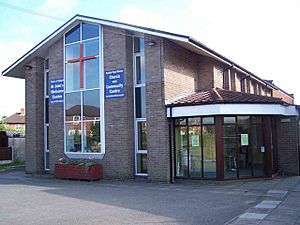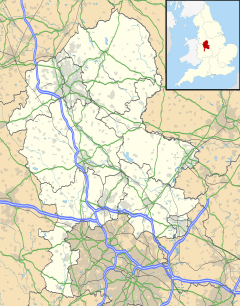Abbey Hulton facts for kids
Quick facts for kids Abbey Hulton |
|
|---|---|
 Abbey Hulton, St. John |
|
| Population | 9,918 (2011 ward of Abbey Hulton and Townsend) |
| OS grid reference | SJ9148 |
| Shire county | |
| Region | |
| Country | England |
| Sovereign state | United Kingdom |
| Post town | Stoke-on-Trent |
| Postcode district | ST2 |
| Police | Staffordshire |
| Fire | Staffordshire |
| Ambulance | West Midlands |
| EU Parliament | West Midlands |
Abbey Hulton is a place in Stoke-on-Trent, Staffordshire, England. It got its name from an old abbey (a type of monastery) that was there many centuries ago, from the 1200s to the 1500s.
Contents
A Look Back in Time
What's in a Name?
The name Abbey Hulton comes from two parts. The "Hulton" part means 'hilltown'. This name comes from old English words like hyll (hill) and tūn (town). Later, the word "abbey" was added. This was because a special Cistercian abbey was built there in 1223.
Early Records
Abbey Hulton is mentioned in a very old book called the Domesday Book. This book was made in 1086 by William the Conqueror. It listed all the towns and lands in England. In this book, Abbey Hulton was called Heltone. It was part of an area known as Pirehill Hundred. At that time, a person named Robert de Stafford owned the land.
The Abbey's Beginning
A man named Henry de Aldithley started the Cistercian Abbey of St. Mary at Hulton in 1223. He gave a lot of land to the monks. Some of this land was passed down from his mother. Other parts he bought himself.
Henry's gifts included villages like Julton and Rushton. He also gave woods, meadows, and other lands. He even promised to pay the abbey 10 marks each year from Audley church.
Later, in 1232, Henry gave even more land. This was in exchange for the monks praying for important people. Thirteen monks were asked to say mass every day forever. This was for the souls of Henry, his family, and his overlord, Ranulph, Earl of Chester. Henry de Aldithley was known as a great supporter of the monks at Hulton Abbey. Over the years, his family and other local lords gave more gifts to the abbey.
Life at the Abbey
Compared to other large abbeys in England, Hulton Abbey was quite small. It was also not very rich. The monks who lived there worked hard. They grew crops and raised sheep. They also ran a tannery, which is a place where leather is made.
The Abbey's End
Sadly, Hulton Abbey was closed down in 1538. This was part of a bigger event called the Dissolution of the Monasteries. After it closed, its lands were sold off.


